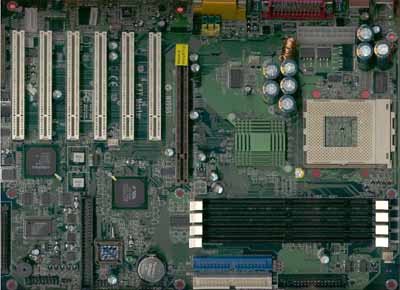Microstar K7T Master Socket-A KT133 ATX
by Henry Kuo on September 28, 2000 1:14 AM EST- Posted in
- Motherboards
Microstar pushes their motherboards to their limits, and the result are clear. Their BX Master, based on the 440BX chipset, earned our AnandTech Editor’s Choice Gold Award in January. The same board was also the first runner up in our 440BX 133MHz Motherboard Roundup in June. They were also the first with a stable Dual VIA Apollo Pro 133A board, the 694D Pro. Next came the Microstar K7T Pro in July, one of the most stable KT133 motherboards tested in our lab.
After these successes, Microstar could have easily sat back and relaxed, but instead they’ve wisely chosen to keep releasing quality products. Their philosophy is clear – to design stable and high-performance motherboards for all users. The K7T Pro is designed to satisfy the vast majority of users, but at the same time they were preparing another version of this board for high-end users. They decided to put in more features on this motherboard to make sure that high-end users and companies would both love it. They designed this motherboard for use in servers and workstations.
They call it, the Microstar K7T Master.
|
Microstar K7T Master |
|
|
CPU
Interface
|
Socket-A
|
|
Chipset
|
VIA
KT133
|
|
Form
Factor
|
ATX
|
|
Bus
Speeds
|
100
/ 102 / 103 / 107 / 110 / 113 / 117 / 120 / 133 / 135 / 137 / 140 / 143
/ 145 / 150 MHz
|
|
Voltages
Supported
|
Auto Detect
|
|
Memory
Slots
|
4
168-pin DIMM Slots
|
|
Expansion
Slots
|
1 AGP Pro 50 Slot 6 PCI Slots (3 Full Length) 1 CNR Slot (Shared) 0 ISA Slot |
|
On-board
Audio
|
VIA
VT1611A AC97 CODEC
|
|
BIOS
|
Award
Modular BIOS 6.00PG
|
The Good
It seems to be a trend that many KT133 motherboards utilize a large size of PCB, and the K7T Master is no exception. It is about 12 by 9.5 inches, close to the size of an ABIT KT7 or ASUS A7V. This means two things; Microstar needed more space to physically fit in all the components, but at the same time it can be a problem for users with smaller cases. If your case is not large enough, the drives bays may be too interfere with the DIMM slots.
Moreover, the 462-pin Socket-A is placed close to the right edge of the motherboard. This puts the power supply very close to the CPU and can be troublesome if you want to remove your heat sink .. The power supply connector is next to the serial / parallel ports and the CPU socket. This means that you will have to run your ATX power cable over the memoriy and CPU, potentially cluttering the case with cables. So far, the best KT133 board in this respect has been the ABIT KT7, which places these connectors on the right edge of the PCB.
The VIA 8373 North Bridge sits to the left of the 462-pin Socket-A connector, which is the core of the KT133 chipset. It provides all the major features of the KT133, including the 133 MHz memory bus and AGP 4X support. Unlike most of the motherboards in the market today, Microstar equipped the K7T Master with the AGP Pro slot. Although it is not really useful now, an AGP Pro slot may come in handy with the next generation video cards. The AGP Pro Slot is still a “universal slot,” which means it is not keyed specifically for AGP 2X or AGP 4X cards, so the user can install almost any current AGP card in the slot.











0 Comments
View All Comments